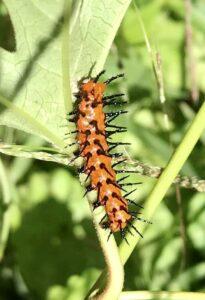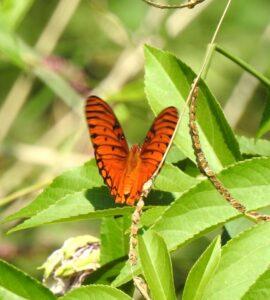Ask most people what Tennessee’s state flower is, and most will immediately answer the purple iris. Ask about the state wildflower and you may very well get the cocked head expression of a confused dog.
The purple iris was named the state flower in 1933, a designation driven largely by Nashville, which was aiming to be known as the “Iris City.” Though there are irises native to Tennessee, our state purple iris is a cultivated hybrid, as are most iris bulbs you’ll find in most garden centers.

Gulf fritillary caterpillar munching on passion flower vines (photo by Beth Kinnane)
One thing the state legislature failed to do when crowning Nashville’s favorite was to rescind the prior designation given to Passiflora incarnata, the passion flower, in 1919. Also known as passion vine, maypops, ocoee and wild apricot, the plant is native to Tennessee and most of the southern United States, down into Mexico and Central and South America.
So, for 40 years the state had two official flowers. In 1973, the legislature created separated categories for each, with the iris as cultivated and passion flower as wild. In 2012, the rare and threatened Tennessee purple coneflower (Echinacea tennesseensis) was named as an additional state wildflower. Not to be confused with the more common eastern purple coneflower (Echinacea purpurea), it was once thought to be extinct until rediscovered in the late 1960s. It thrives in Cedar glades in three counties in middle Tennessee. Of note, all three of our state flowers have purple blooms.
But back to passion flowers, the vines serve an important ecological function, as native plants where they belong tend to do. While their blooms provide a nectar source to a variety of pollinators, they are the host plant for the caterpillars of the Gulf fritillary butterfly. It’s great to provide blooming plants that provide nectar for the bees, butterflies and hummingbirds. But even more essential are the plants those larval young of the moths and butterflies need to eat. And many are quite specific.
Most people are thankfully now aware of the need to plant native to area milkweeds (leave the tropical for the tropics, please) for the survival of the monarch butterfly. Likewise, the gulf fritillary must have passion vines upon which to lay their eggs. Their baby caterpillars munch on the leaves until time to form a chrysalis and make the transformation to butterfly. Not quite as large as monarchs or viceroys, they are a medium large species, a lovely burnt orange color.
Several of the Gulf fritillary’s close cousins use our native purple violets as larval host plants, including the variegated and the great spangled. Yes, those lovely native wildflowers many fight to extirpate from their highly invasive lawn grasses are an essential host plant for a variety of butterflies.
I started making the move to native plant gardening six years ago for some perfectly lazy reasons. I want flowers in my yard, but I don’t have the patience for fussy ones (I’m looking at you, gardenias). As a rule, native plants aren’t fussy. Keep them watered the first year and during droughts. That’s kinda it. I also wanted to be able to plant densely (think English cottage garden not English manor manicured garden) to get out of the mulch routine because I don’t like working outside in the heat.

Gulf fritillary butterfly laying eggs on passion flower vines (photo by Beth Kinnane)
But along the way I learned how much different plants mean to the pollinators we depend on to live. And that with those plants I have a yard full of birds without ever having to hang a feeder. The hummingbirds prefer the cardinal flowers. And how important it is not to use pesticides (psst, there is no such thing as one that *only* kills mosquitoes, ticks and fleas).
This is the time of year that my native garden does tend to get a bit unruly, and it will be so until after the first frost. To start cleaning up now would destroy who knows how many future butterflies among the bumper crop of milkweed, passionvine or the pawpaws for our state buttfly, the zebra swallowtail. All this to say, have a look at what’s supposed to grow in your own backyard before sticking an invasive species in it.
Beth Kinnane writes a history feature for KnoxTNToday.com. It’s published each Tuesday and is one of our best-read features.
Sources: Tennessee State Archives



